All knowledge is conjectural. It's always being guests. It's our best understanding at any given time. You're right to say that the axioms might be incorrect. How do we know that an axiom is incorrect? Traditionally, the answer is banned because it's clearly an obviously the case, how can you prove that X plus zero must equal x. Well, you just have to accept that it's true. But if we consider something like Euclid's elements, for example, draw two points on a piece of paper.
Paper now through those two points a unique straight line can be drawn.
This was accepted as true for centuries when anyone listening might want to try the experiment for themselves. Take a piece of paper. Take a pen draw two dots on the piece of paper.
Now how many unique straight lines. Can you draw through those two dots it should be fairly obvious to you that only one such line can be
drawn. However, we now know that's false. I just want
Reflect as you're staring at the piece of paper through
which only one straight line is being drawn. You
have the feeling of certainty you are absolutely sure that you're not wrong. This feeling is something we should always be skeptical of because when people have been absolutely certain even in a domain as apparently full of
certainty as mathematics, they've been shown to be wrong. So how can we show it wrong? Here's what you do and you might think that I'm cheating but
then again you have to reflect on did
You understand what I was saying.
When I first told you to draw a unique straight line through these two points.
Here's what I want you to do bend the piece of paper think in three dimensions wrap the piece of paper around a basketball. If you have one
now consider the ways in which you could draw a straight line through those two points, you could punch a hole through one of those dots with your pen and push it out through the other side through the other hole. And now you have a different straight line. You have the straight line that is drawn with your pain and you
A straight line that is literally your pain that has been pushed through these two dots
so your initial feeling of absolute certainty that only a unique line could be drawn through these two dots is false and you might be
thinking that's unfair that's cheating. You were thinking in two Dimensions, but you were thinking in two Dimensions. I
wasn't I was thinking more
Dimensions that Karl Popper has this wonderful saying it is
impossible to speak in such a way
that you cannot be misunderstood.
This is always the case. So even in
mathematics
Where we try and be as
precise as possible. It's possible for people to make errors to think
false premises about what the argument is that they're trying to make and by the way this particular example of Canadian geometry because geometry was traditionally always done in two dimensions on a piece of paper was resolved by various people and led to geometry in curved space which led to Einstein coming up with general theory of relativity. So it is questioning
these deepest assumptions that we have where we think
Think there's no
possible way. We could be mistaken that leads to True progress to genuine fundamental change in the sciences and everywhere else.

